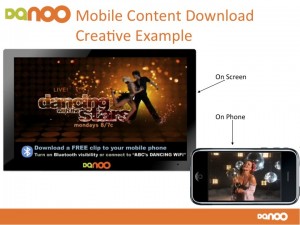Danoo’s Next Play – Integrating Mobile Campaigns
Manolo Almagro, Q Division Managing Partner
On June 10th, Danoo issued a press release announcing the results from the recent tests with integrated mobile campaigns. Rather than just do what every other industry blog does and repost the canned commentary and the press release, I asked Doug Scott, Danoo’s VP Marketing & Business Development to give me some details on how the campaigns were executed.

Manolo: Can you explain the typical user registration/opt-in experience?
Doug: From once the user is prompted if they want to download the file. If bluetooth is on and discoverable on the phone, the user will typically be prompted automatically. On some phones, for example, the Blackberry – a user will be asked to pair the device. The full experience depends on factors such as file size and range from the device. On average a 15 second clip will download in under 10 seconds. A static image or ringtone will take approximately 5 seconds.
Manolo: What type of user profile data is captured by the Blue Bite technology? Can you get some good stuff like- the bluetooth chip ID? location, previous visits. Lifestyle of phone owner? (as in –are they an iphone user vs. Samsung Smartphone or Blackberry User)
Doug: Blue Bite collects the Bluetooth ID of the phone which is unique to every device, which allows us to see if we have interacted with that individual at this location before, at other locations, and what actions that person performed (downloaded, rejected, ignored) for various campaigns. This allows us to control the user experiences — for example, not prompt someone who has already downloaded the content or has rejected the campaign in the past. We can also detect the model of the phone (i.e. Nokia 5300) so that we can analyze trends, such as download rate across different phone types.
Manolo: What is the approximate number of downloads expected when Danoo rolls this out network wide? – how many simultaneous downloads (of 15 sec vid files) can the bluetooth player support? How is the content “harmonized” as in- how many types of file formats are available (to support the various types of handsets)
Doug: Blue Bite is compatible with 1,300 unique devices, of these personal mobile devices, close to 1,200 of them -support video playback and all but a few support audio playback and image viewing. While the on-location server can support only 21 simultaneous downloads, we have optimized this process to ensure a tolerable user experience.
Manolo: How was bluetooth/wifi vendor (Bluebyte) selected? Who was the second choice? – what was the selection criteria, and how does their user experience differ from the other’s on the market?
Doug: After a broad evaluation, Blue Bite was selected based on the following criteria:
- The ability to support and optimize the content downloads across the most handsets, ensuring the most downloads and the best user experience.
- The technology was compliant with Danoo’s engineering standards and requirements
- As a vendor/partner, the folks at Blue Bite shared the same commitment to ensuring that advertisers and consumers had the best possible experience by developing and driving best practices
Campaign Results?
On average, 10% of Danoo’s audience had their mobile device set to “discoverable”, nearly one-third above the national average, and of those viewers, 28% opted-in to receive the mobile content download. Doing the math, you get a download rate of close to about 3% of total venue traffic.
In my opinion, the fact that Danoo’s test market was conducted in a state with a Headset law -provided better than average conditions for bluetooth enabled phones to be set for “discoverable” mode. However, the results are still pretty good for a mobile campaign. I’m anxious to see what happens when they roll this out over the entire Danoo network.




June 13th, 2009 at 12:48 @575
In the Philippines, virtually all celphones have their bluetooth switched off because of rampant virus infections. Specially with nokias, when you send a business card via bluetooth, the target device just accepts it without a prompt for approval. i wonder if you have the same problem there with cellphones getting infected using the bluetooth connection. a particular virus automates the cell to forward inane messages via sms and mms. so bluetooth is pretty much a dead medium here.
most networks here first send a txt message with links or a prompt to reply. content is mostly interactive infotainment and games that offer a chance to win a cash or a prize. (…brought to you by…)
June 14th, 2009 at 16:20 @722
Elijah – the folks in the States aren’t even close to the level of mobile phone users at the my peeps in the Philippines, not many virus issues…yet. -But you have made a good point – its just a matter of time before we may see such things in the US. I’ve had SMS experiences with Globe Telecom and Smart as it relates to promotions. I imagine the SMS participation with the game shows on Philippine Television make for very effective campaigns. If you have more details on the local mobile marketing side of things, i’d be interested hear about them, you can find me on twitter if you want to connect.
June 16th, 2009 at 18:47 @824
Re Elijah – I thought the Philippines was ions ahead of us way behind USA folks! I heard you have the higest text messaging usuage and such.
Manolo – so how far behind are we in the USA? 3 years?
-m-
June 17th, 2009 at 23:26 @018
the latest research data – has China and Philippines as the number 1 and 2 txt’ing usage countries. I think the usage is driven by 2 economic factors- as it costs more to make a call vs. sending txts. And in the case of the Philippines – its still classifies as a 3rd world country so people opt for the cheaper way. Keeping that in mind, consider that use of the mobile has a different place in each cultural. Most filipinos keep at least 2 mobiles and upgrade their units once a year. In the Philippines, Korea and Japan, people use their phones for much more than just getting calls/txts, – they use them on vending machines, to send money to relatives and such. In the US, we’ve just discovered the Iphone, and texting is for the younger set. Excluding the boom of the iphone- I’d venture a guess that US use of the mobile phone beyond making calls and txting is about 3-5 years behind Asia.